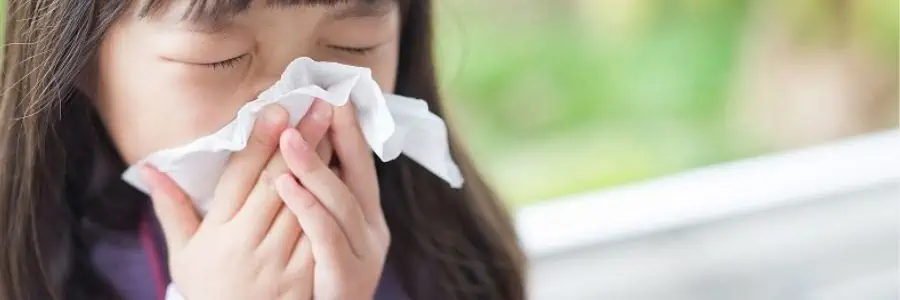
10 Common Childhood Illnesses & Some Helpful Tips to Manage Them

On average, children fall sick about seven to eight times a year. Their susceptibility to illnesses could be due to their underdeveloped immune system and exposure to germs at schools or child care facilities. As parents, it is important to understand the symptoms of common illnesses and how to manage them to prevent the sickness from progressing to an advanced and more severe stage.
Here are 10 examples of some of the most common childhood illnesses, and a few tips on how you can manage them:
Content:
- Common Cold and Influenza
- Ear Infections
- Bronchitis and Bronchiolitis
- Hand-Foot-and-Mouth Disease
- Gastroenteritis
- Eczema
- Asthma
- Allergic Rhinitis
- Constipation
- Chickenpox
1. Common Cold and Influenza
The common cold and the flu share many similar symptoms, but are both caused by different viruses. The influenza virus causes a flu, whereas different viruses can cause a cold. Generally, a flu is more serious, with more intense symptoms that begin abruptly. Additionally, a flu can lead to more serious complications, such as pneumonia.
Does your child have the flu or a cold? Here’s how they differ:
| Symptoms | Flu | Cold |
| Fever | Usually high (38°-41°C), lasts 3-4 days | Uncommon |
| Headache | Very common | Uncommon |
| Aches | Common and often severe | Slight |
| Tiredness | Can be severe | Mild, uncommon |
| Stuffy nose | Sometimes | Common |
| Sneezing | Sometimes | Common |
| Sore throat | Sometimes | Mild to moderate |
| Cough | Dry, intense | Mild |
Things you can do to help:
- Keep them hydrated with plenty of water or low-sugar juices
- Use nasal sprays or drops to clear up nasal congestion
- Ensure the child gets extra rest
- Remember to check with a paediatrician before giving your child over-the-counter medication. The dosage may differ, depending on the child’s age and weight
2. Ear Infections
Ear infections are another popular childhood illness. It is caused by bacteria or viruses that infect the space behind the eardrum, and it can be very painful for children. The ‘middle ear’ fills with pus which pushes on the eardrum, causing a lot of discomfort.

Aches/pain in the ear are the obvious signs of an ear infection. However, children may also have fever and difficulty sleeping.
Things you can do to help:
- Consult your pediatrician to determine whether fever and pain medication can be given
- Place a cold compress on the outer ear for 10-20 minutes. If your child prefers a warm compress, you may use a warm washcloth.
- Ease some of the pressure on the ear by elevating the child’s head
3. Bronchitis and Bronchiolitis
Bronchitis indicates an inflammation of the lungs and an overproduction of mucus. It is typically caused by a virus – although it may also be brought on by bacteria. Bronchiolitis, a viral infection, causes the lungs to swell, making it difficult for children to breathe.
If your child is making a high-pitched whistling sound (i.e. wheezing) or is finding it difficult to eat, it could signify an infection of the lungs. Some of the other symptoms of bronchiolitis can be similar to a cold, such as sneezing and having a runny or blocked nose. Similarly, bronchitis may be accompanied by fever, a lack of energy and frequent coughing.
A common complication of this childhood illness is an ear infection. In rare cases, it can lead to pneumonia.

Things you can do to help:
- Hydration is key – make sure the child is drinking enough fluids
- Use saline drops (or bulb suctioning) to ease any nasal congestion
- See a doctor if the child is wheezing – the doctor may need to prescribe bronchodilators and/or anti-inflammatory drugs
4. Hand-Foot-and-Mouth Disease
You will most probably have heard of HFMD – a contagious, yet mild childhood illness that is characterized by rashes on hands, feet and the diaper area, together with ulcers in the throat, mouth and tongue. Children will also typically have fever and a loss of appetite. It can spread through direct contact with the nasal discharge, saliva and fluid from the rash of an infected individual.
The ulcers can be painful and the blister-like rashes may be uncomfortable for the child, but HFMD is a minor viral infection illness that usually lasts for only a few days.

Things you can do to help:
- A soft diet (e.g., porridge, soup, pureed fruit) may help, if the mouth ulcers make it too uncomfortable for the child to eat
- Ensure the child drinks plenty of water
- Giving medications as prescribed by a pediatrician – e.g., paracetamol to relieve fever
5. Gastroenteritis
Gastroenteritis is an infection by bacteria or viruses in the stomach or intestines. Although it is not strictly a childhood illness, children may also get infected by it quite often. Infection occurs if children touch contaminated items and then touch their food or mouth, or if they share drinks with infected people. The main signs are usually vomiting and diarrhea. The child may also have fever, abdominal pain, body aches, bloating and loss of appetite.
Diarrhea and vomiting can lead to dehydration. Mild dehydration can be treated with oral rehydration solutions. In rare cases, severe dehydration may need treatment in the hospital.
Things you can do to help:
- Watch out for signs of dehydration to prevent it getting worse – dry mouth, not passing urine, cold hands and feet are all indicators of dehydration
- Treat mild dehydration with oral rehydration solutions – these can be bought over the counter without a doctor’s prescription
- Visit the doctor if your child has recurring episodes of vomiting and diarrhea – the doctor may prescribe anti-vomiting medicine
6. Eczema

Unlike most childhood illnesses, eczema is not infectious. In fact, children with eczema usually have a family history of eczema or other related conditions like asthma and hay fever. Usually, children with eczema have dry, itchy, bumpy and inflamed skin.
Infants typically have the rash on their cheeks, forehead and scalp. Sometimes it might spread to the knees, elbows and trunk. Older children usually get rashes behind the knees, on the wrists, ankles, or on the neck. Their skin may also be thicker or scarred from scratching.
Things you can do to help:
- Moisturizing your child’s skin is important as it helps to control flare-ups by preventing dryness and keeping out irritants
- Allow your children to wear soft, cotton clothing
- Try to eliminate known allergens around the home, such as pollen, mold and tobacco smoke
- Use OTC creams/lotions according to the prescribed length of time – consult a doctor if you’re not sure
Click here to be redirected to our article on eczema to find out more about this skin condition!
7. Asthma

Sometimes, it may be tricky to determine whether a child who is coughing or wheezing is suffering from asthma or another respiratory problem, such as bronchitis. One of the main signs of asthma includes frequent coughing, which worsens when the child has a viral infection, or is triggered by exercise or cold air. Other symptoms include a wheezing sound when breathing out, shortness of breath and chest congestion.
Asthma in children may also lead to tiredness, trouble sleeping and a delayed recovery after a respiratory infection.
Things you can do to help:
- Limit the child’s exposure to asthma triggers (e.g., tobacco smoke, dust mites, pollen)
- Try to maintain a healthy weight – if the child is overweight, it may worsen his symptoms and puts them at risk of other health complications
- Consult with a doctor to determine whether your child needs long-term controlled medications such as inhalers or oral medications.
8. Allergic Rhinitis
When children come into contact with allergens, it triggers the release of histamine and other chemicals in the body, which can cause allergy symptoms such as nasal congestion, runny nose, ear infections, coughing, wheezing, nosebleeds and sore throat.
Some of the most common triggers are pollen from plants, dust mites, mold, cockroach waste and animal fur.

Things you can do to help:
- Control the child’s environment by eliminating as many allergens as you can. (e.g., use air purifiers/air conditioners, staying away from areas with dust mites)
- Reducing the number of soft toys and carpets in the bedroom can help to lessen the amount of dust mites
9. Constipation
If your child has less than 3 bowel movements in a week, or if their poo is large and hard, they may be constipated. Other signs include straining or feeling pain when the child is trying to poo, bleeding during or after having a poo, or having stomach pain that improves after going to the toilet.
One of the causes of constipation is not having enough high-fibre foods (e.g., fruits and vegetables) and not drinking enough water. There are also behavioural causes of constipation – for instance, feeling pressured or being interrupted during their toilet time, or feeling anxious in unfamiliar surroundings.

Children with constipation sometimes find it painful to poo, which may lead them not to try going to the toilet. However, the more they restrain, the more constipated they can get. Water gets reabsorbed into the body, causing stools to harden.
Things you can do to help:
- Laxatives are usually recommended, but medication for constipation mostly depends on the child’s age. Make sure to consult your pediatrician first
- Remember to incorporate a lot of vegetables and fruit in your children’s diet
- Encourage them to be physically active – a sedentary lifestyle tends to counteract the natural stimulation of the intestines to move and process bowel movements
10. Chickenpox

Chickenpox is a viral infection, caused by the varicella-zoster virus. It produces itchy rashes with small fluid-filled blisters. It is a common childhood illness, as it is highly contagious for children who haven’t been previously exposed to it or vaccinated against it.
Before the child gets rashes, they would typically have fever, loss of appetite and would be feeling generally tired. The rashes usually appear a week or two after exposure to the virus, and last for a few days. The rashes start out as pink/red bumps, and may evolve to become small fluid-filled blisters. Once the blisters break and leak, it forms a scab which can take several days to heal.
Generally, it is a mild disease, but in severe cases, the rash may be accompanied by dizziness, vomiting and loss of muscle coordination.
Things you can do to help:
- Applying calamine lotion can help to relieve some of the itching
- Try to keep the children’s fingernails short to minimize scratching
- Provide cold, soft and bland foods as it may be uncomfortable for those with blisters near the mouth to eat. Avoid acidic or salty foods.
- Antiviral medication may be prescribed, depending on the child’s age and health, and the timing of the treatment
Thank you for reading our article!
If you have any further questions, you can always pay us a visit at our child specialist clinic
References:
- NCIRD, C. D. C. (2021, September 16). Cold versus flu. Centers for Disease Control and Prevention. https://www.cdc.gov/flu/symptoms/coldflu.html
- Otitis Media – Atlantic Ear, Nose & Throat. (2020, September 8). Otitis Media. http://myentdoctor.com/2020/09/08/otitis-media/
- Health Hub Singapore. (2021, September 2). Childhood Illnesses: 10 Most Common Conditions in Children. https://www.healthhub.sg/a-z/diseases-and-conditions/640/top-10-common-childhood-conditions-ehb

Pingback: General Pediatrics & Outpatient Care: Find out how your pediatrician can help to care for your child - FirstStep Child Specialist Clinic
Pingback: Effective ways to manage and prevent the stomach flu - FirstStep Child Specialist Clinic
Pingback: 5 Types of Diagnostic Tests Provided at the Clinic - FirstStep Child Specialist Clinic